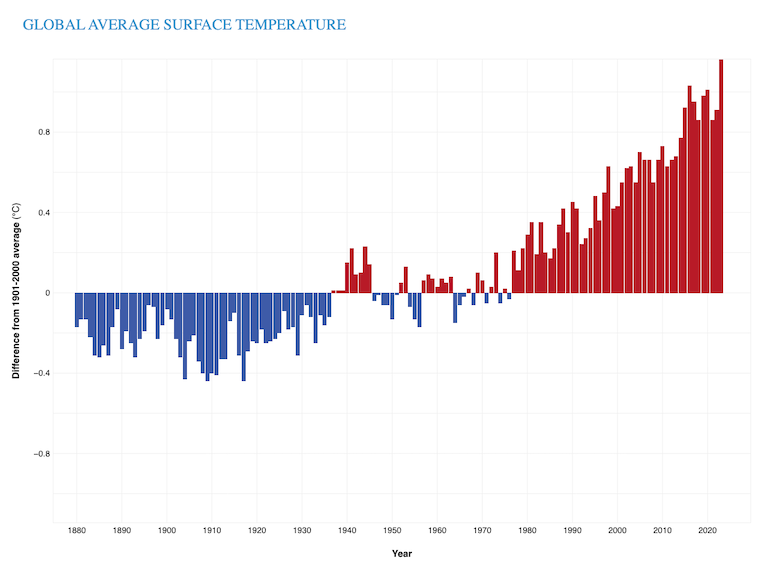Given record-setting heat waves around the world in recent years, an international team of researchers led by scientists at UC Santa Cruz investigated if the rate of global warming has increased significantly, or “surged,” over the last half century at statistically detectable rates.
The new study, published on October 14 in the journal Nature Communications Earth & Environment, confirms the broad consensus that the planet is getting warmer, but at a statistically steady rate—not at a sufficiently accelerated rate that could be statistically defined as a surge.
Recent years have seen record-breaking temperatures and heat waves globally: Data show 2023 was the warmest year since global records began in 1850—by a wide margin—and that the 10 warmest years in the historical record have all occurred in the past decade (2014-2023).
These record temperatures have spurred discussion and debate about whether the rate of global warming has increased, with some arguing that it has accelerated over the past 15 years. However, the team’s findings demonstrate a lack of statistical evidence for an increased warming rate that could be defined as a surge.
"We've had these record-breaking temperatures recently. But that's not necessarily inconsistent with steadily increasing global warming,” said lead author Claudie Beaulieu, professor of ocean sciences at UC Santa Cruz. “Of course, it is still possible that an acceleration in global warming is occurring. But we found that the magnitude of the acceleration is either statistically too small, or there isn’t enough data yet to robustly detect it.”
Defining and detecting a surge
The research team performed a rigorous analysis of sets of global surface-temperature averages from the four main agencies that track the average temperature of Earth’s surface, including NASA and the National Oceanic and Atmospheric Association (NOAA)—dating back to 1850. Since that year, Earth’s temperature has risen by 0.11-degree Fahrenheit per decade, according to NOAA.
Specifically, the study analyzed the “global mean surface temperature” (GMST), which is widely studied to monitor climate change, but also presented some challenges: GMST tends to rise over time due to human-caused pressures, and it fluctuates around that long-term trend because of natural phenomena—like major volcanic eruptions and the El Niño Southern Oscillation—that affect global temperatures. Thus, distinguishing between that natural variability and true underlying changes in the pace of warming is a statistical challenge, the team acknowledged.
Their analysis deemed an increased warming surge to be statistically detectable if it exceeded and sustained a level above those temporary fluctuations over a long period of time. Imagine temperature records plotted on a graph: A small change in the slope would require more time to detect it as significant, whereas a large change would be evident quicker.
After accounting for short-term average temperature fluctuations—which can mask long-term trends and create the appearance of slowdowns and surges in warming—and using a range of statistical methods, the team determined the level of increased warming that would be needed for a given number of years in order to detect surges.
For example, they identified that, for the year 2012, the rate of warming would have needed to increase by at least 55% before its trajectory could be statistically detectable in 2024—and therefore be called a “surge.” In another example, they show that a change in the warming rate of around 35% in 2010 would become statistically detectable by around 2035.
No recent surge detected, yet
The team, which included researchers in the UK, applied that threshold in their statistical analysis of more recent records dating back to the 1970s to see if temperature trends crossed that threshold, and found that none did. “Our concern with the current discussion around the presence of a ‘surge’ is that there was no rigorous statistical treatment or evidence,” said study co-author Rebecca Killick, a statistics professor at Lancaster University. "We decided to address this head on, using all commonly used statistical approaches and comparing their results.”
Their study also provides the minimum percentages for statistical detectability in the years ahead, up to 2040.
“Alongside our results, we give a benchmark to scientists, a minimum threshold that must be exceeded before a change may be detectable,” Killick explained. “We hope this helps add rigor to future discussions on potential surges or hiatus.”
Although their findings show no statistical evidence that we are in the midst of a warming surge, Beaulieu emphasized that they aren’t refuting the reality of climate change.
“Earth is the warmest it has ever been since the start of the instrumental record because of human activities—and to be clear, our analysis demonstrates the ongoing warming,” Beaulieu said. “However, if there's an acceleration in global warming, we can't statistically detect it yet."
“When coupled with other studies I've recently done, which include generally declining snow cover in the Northern Hemisphere and changes in hurricane and tropical cyclone counts, the work shows that the Earth's climate is changing, and more often than not, the changes are bad for humans,” said co-author Robert Lund, professor and department chair of statistics at the UC Santa Cruz Baskin School of Engineering.
Other co-authors on the paper, “A Recent Surge in Global Warming is not Detectable Yet,” are Colin Gallagher, director for the School of Mathematical and Statistical Sciences at Clemson University;; and Xueheng Shi, assistant professor of statistics at the University of Nebraska-Lincoln.



